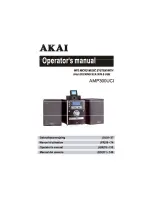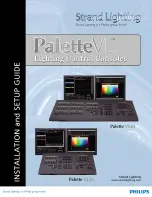
Vision manual page:21
6.0 Stereo deluxe input module
This stereo module is a flexible stereo module. This module can be used for stereo keyboards, drum machines, or
any device needing two inputs on one fader. The paragraphs below describe stereo input module in full.
6.1 Input section
The
MONO
switch lets you combine the two input signals into one output signal. It is also possible to feed one
input signal to both outputs of the module.
The
PHASE
switch reverses the balanced line A input wires incase a phase reverse problem needs to be
cured.
LINE B
switches the Line A input to the line B input of the channel.
The line has its own balanced input amp and is controlled by the active (dual) gain control. The input section
consist of a stereo
GAIN
control.
The gain control is a dual pot used to adjust the gain of two line
amps (balanced stereo input). The adjustment range is from - 20dB to + 20 dB.
NOTE:
In the line B input an optionally available RIAA phono correction amplifier is available.
6.2 Equalizer section
The four band stereo equalizer was designed for the type of equalization needed for stereo returns.
The high frequency band is a shelving type at 12,000 Hz. The low frequency band is a shelving type at 60
Hz.
The HMF mid band has a bell curve at 5 kHz.
The LMF mid band has a bell curve with a centre frequency of 250 Hz. Each band has a boost or cut of
16dB.The Equalizer can be switched in and out of the signal paths.
The
HIGH PASS
filter is a rumble filter with a turnover frequency at 5 0Hz. It has a gentle roll off of 9 dB per
octave.
6.3 Aux send section
The Vision has eight auxiliary send busses. While in the tracking session, some aux sends are used for feeding
the headphones and some are used for effects sends. During the mix session, all aux sends are used for
effects sends.
Aux
iliary sends
1&2
are on dual concentric controls. The top control is the send control for aux 1 and the
bottom control is the send for aux 2. These Aux busses are normally used for stereo headphone sends in the
tracking session. A PRE switch puts them pre fader for fold back purposes.
Aux 3&4
and
Aux 5&6
are also on dual concentric controls with the top control as Aux 3 /5 and the bottom
control as Aux 4/6. The internal jumper setting for both concentric controls are post fader. A pre selection
is easy accomplished.
Aux 7&8
are also on dual concentrics and factory set post fader. A jumper can change this to pre fader if
wanted. All eight aux sends are summed stereo signal sends.
6.4 Channel assign section
The
Channel assign
section allows the user to assign to a maximum of 8 busses. The routing gives selection
to the 8 group modules using two pushbuttons. With each pair of summing amps, you have the choice of
assigning to the odd and even groups.
The
L/R
switch (in the assign section) assigns the signal to the stereo mix buss while the balance control
compensates for any unbalances in the input signal.
The Vision's summing amp and internal structure means that it is extremely quiet and distortion free.
The MUTE switch is a momentary switch that controls a silent FET switch
to mute the channel. The FET can also be controlled by the optional MIDI mute module.
The
SOLO
switch has two modes, stereo pfl (pre fade listen) or a “non-destructive” stereo solo-in-place system.
Master status switching (located in the master section) selects the “solo in-place” or “PFL” mode for the entire
console. Activating the solo switch in the pfl mode will send the prefader signal to the CRM speakers. In the solo in-
place mode, the post monitor pan pot signal is heard. A solo indicator LED is fitted next to the solo switch.
6.5 Ledbar section
















































